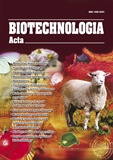ISSN 2410-7751 (Print)
ISSN 2410-776X (Online)

Biotechnologia Acta Т. 17, No. 6, 2024
P. 5-14, Bibliography 21, Engl.
UDC: 577.175.8, 577.175.8, 612.3/.8 : 577 : 57.02 : 502/504
doi: https://doi.org/10.15407/biotech17.06.005
Full text: (PDF, in English)
1 - L.V. Pisarzhevskii Institute of Physical Chemistry of the National Academy of Sciences of Ukraine, Kyiv
2 - O.V. Palladin Institute of Biochemistry, the National Academy of Sciences of Ukraine, Kyiv
Aim. In biomedical applications, silica nanoparticles are promising for controlled drug delivery. Also, from an environmental point of view, silica accounts for the most significant part of the mass of air pollution, particularly matter components, especially during sand dust storms.
Methods. Amino-grafted mesoporous silica nanoparticles (MSN-NH2) were synthesized by means of co-condensation of tetraethoxysilane and 3-aminopropyltriethoxysilane and characterized using TEM, IR-spectroscopy, and powder X-ray diffraction. Neuromodulatory and related properties of MSN-NH2 were evaluated using rat cortex nerve terminals (synaptosomes).
Results. MSN-NH2 did not influence the extracellular synaptosomal level of excitatory neurotransmitter L-[14C]glutamate and so did not cause excitotoxicity. In fluorescence measurements, MSN-NH2 depolarised the synaptosomal membrane and demonstrated weak antioxidant properties, decreasing the spontaneous generation of reactive oxygen species, whereas MSN-NH2 did not alter H2O2 in nerve terminals. The model of Cd2+/Pb2+/Hg2+-induced excitotoxicity was used to assess the capability of MSN-NH2 to adsorb xenobiotic heavy metals. MSN-NH2 did not modulate the Cd2+/Pb2+/Hg2+-induced increase in the extracellular synaptosomal level of L-[14C]glutamate.
Conclusion. MSN-NH2 did not demonstrate excitotoxic signs, had weak antioxidant properties, and was biocompatible. MSN-NH2 did not mitigate the excitotoxic effects of xenobiotic heavy metals and did not adsorb these metals in biological systems.
Key words: mesoporous amino-grafted silica nanoparticles; neuromodulatory, membranotropic, antioxidant properties; xenobiotic heavy metals; glutamate; cortex nerve terminals.
© Palladin Institute of Biochemistry of the National Academy of Sciences of Ukraine, 2024
References
- Xu B., Li S., Shi R., Liu H. Multifunctional mesoporous silica nanoparticles for biomedical applications. Signal Transduct Target Ther. 2023, 8(1): 1–28. https://www.nature.com/articles/s41392-023-01654-7
- Vallet-Regí M., Colilla M., Izquierdo-Barba I., Manzano M. Mesoporous silica nanoparticles for drug delivery: Current insights. Molecules. 2018, 23(1): 47. https://pubmed.ncbi.nlm.nih.gov/29295564/
- Liu H., Wang X., Talifu D., Ding X., Abulizi A., Tursun Y., An J., Li K., Luo P., Xie X. Distribution and sources of PM2.5-bound free silica in the atmosphere of hyper-arid regions in Hotan, North-West China. Sci Total Environ. 2022, 810:152368. https://doi.org/10.1016/j.scitotenv.2021.152368.
- WHO. Sand and dust storms. 2024. https://www.who.int/news-room/fact-sheets/detail/sand-and-dust-storms
- Landrigan P.J, Fuller R., Acosta N.J.R., et al. The Lancet Commission on pollution and health. Lancet. 2018, 391(10119): 462–512. https://doi.org/1016/S0140-6736(17)32345-0
- Borisova T. Nervous System Injury in Response to Contact With Environmental, Engineered and Planetary Micro- and Nano-Sized Particles. Front Physiol. 2018, 9: 728. https://www.frontiersin.org/article/10.3389/fphys.2018.00728/full
- Tranvik L.J. New light on black carbon. Nat Geosci. 2018, 11(8): 547–548. https://doi.org/10.1038/s41561-018-0181-x
- Sudhof T.C. The synaptic vesicle cycle. Annu Rev Neurosci. 2004, 27: 509–547. https://doi.org/1146/annurev.neuro.26.041002.131412
- Estevão B. M., Miletto I., Hioka N., Marchese L., Gianotti E. Mesoporous silica nanoparticles functionalized with amino groups for biomedical applications. ChemistryOpen. 2021, 10: 1251–1259. https://doi.org/1002/open.202100227
- Kilkenny C., Browne W., Cuthill I.C., Emerson M., Altman D.G. NC3Rs Reporting Guidelines Working Group. Animal research: reporting in vivo experiments: the ARRIVE guidelines. Br J Pharmacol. 2010, 160(7): 1577–1579. http://www.ncbi.nlm.nih.gov/pubmed/20649561
- McGrath J.C., Drummond G.B., McLachlan E.M., Kilkenny C., Wainwright C.L. Guidelines for reporting experiments involving animals: the ARRIVE guidelines. Br J Pharmacol. 2010, 160(7): 1573–1576. http://www.ncbi.nlm.nih.gov/pubmed/20649560
- Cotman C.W. Isolation of synaptosomal and synaptic plasma membrane fractions. Methods Enzymol. 1974, 31: 445–452. http://www.ncbi.nlm.nih.gov/pubmed/4278474
- Krisanova N., Pozdnyakova N., Pastukhov A., Dudarenko M., Maksymchuk O., Parkhomets P., Sivko R., Borisova T. Vitamin D3 deficiency in puberty rats causes presynaptic malfunctioning through alterations in exocytotic release and uptake of glutamate/GABA and expression of EAAC-1/GAT-3 transporters. Food Chem Toxicol. 2019, 123: 142–150. https://linkinghub.elsevier.com/retrieve/pii/S0278691518307944
- Larson E., Howlett B., Jagendorf A. Artificial reductant enhancement of the Lowry method for protein determination. Anal Biochem. 1986, 155(2): 243–248. https://doi.org/10.1016/0003-2697(86)90432-X
- Pozdnyakova N., Pastukhov A., Dudarenko M., Galkin M., Borysov A., Borisova T. Neuroactivity of detonation nanodiamonds: dose-dependent changes in transporter-mediated uptake and ambient level of excitatory/inhibitory neurotransmitters in brain nerve terminals. J Nanobiotechnology. 2016, 14(1): 25. http://jnanobiotechnology.biomedcentral.com/articles/10.1186/s12951-016-0176-y
- Hadwan M.H., Abed H.N. Data supporting the spectrophotometric method for the estimation of catalase activity. Data Br. 2016, 6: 194–199. https://doi.org/10.1016/j.dib.2015.12.012
- Pai P. G., Chao S. S., Takagi Y., Lucovsky G. Infrared spectroscopic study of SiOx films produced by plasma enhanced chemical vapor deposition. Vac. Sci. Technol. A 1986, 4: 689–694. https://doi.org/10.1116/1.573833
- Zhang B.‐R., Yu Z, Collins G. J., Hwang T, Ritchie W. H. Chemical composition of soft vacuum electron beam assisted chemical vapor deposition of silicon nitride/oxynitride films versus substrate temperature. Vac. Sci. Technol. A 1989, 7: 176–188. https://doi.org/10.1116/1.575749
- Méndez-Vivar J., Mendoza-Bandala A. Spectroscopic study on the early stages of the polymerization of hybrid TEOS–RSi (OR′)3 Sols. Non. Cryst. Solids. 2000, 261: 127–136. https://doi.org/10.1016/S0022-3093(99)00605-5
- Borisova T., Borysov A. Putative duality of presynaptic events. Rev Neurosci. 2016, 27: 377–383. https://www.degruyter.com/view/j/revneuro.ahead-of-print/revneuro-2015-0044/revneuro-2015-0044.xml
- Borisova T., Borysov A., Pastukhov A., Krisanova N. Dynamic gradient of glutamate across the membrane: glutamate/aspartate-induced changes in the ambient level of L-[(14)C]glutamate and D-[(3)H]aspartate in rat brain nerve terminals. Cell Mol Neurobiol. 2016, 36(8): 1229–1240. http://www.ncbi.nlm.nih.gov/pubmed/26886753

